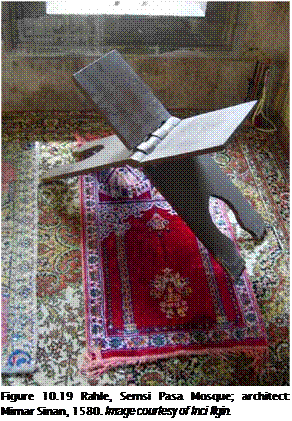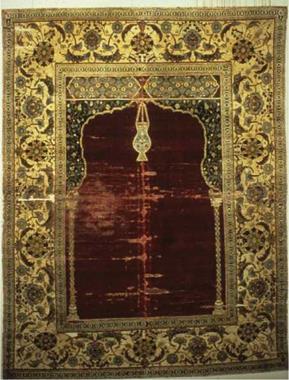The roots of Islamic furniture can be traced to pre-Islamic and Persian societies, which had functional, simple furniture that later developed into more artistic and complex designs before 610 CE. In Islamic society, much of one’s life was spent on the floor; therefore, the rug was considered one of the greatest possessions in a household and was used as furniture (Figure 10.17). People often slept on mattresses on the floor that were folded and stored in cupboards during the day.
The use of ornamentation was prevalent in pre-Islamic design and appeared in woven textiles as well as in carved and inlaid chests. The four basic types of ornament are calligraphy, vegetal patterns, geometric patterns, and abstract figural representation. This type of ornamentation was referred to in Europe as arabesque and was popular as a style until the early seventeenth century. (Although figural representation is prohibited by the Koran, abstract figural images do exist in woven rugs.) All four types of ornament assist in telling stories that preserve Islamic history.
 Geometric ornamentation reached a pinnacle in the Islamic world. Sources for the shapes and patterns existed in late antiquity among the Greeks, Romans, and Persians. The
Geometric ornamentation reached a pinnacle in the Islamic world. Sources for the shapes and patterns existed in late antiquity among the Greeks, Romans, and Persians. The
|
|
|
Figure 10.17 Islamic prayer rug. Photography by Jim Postell, 2006. |
 |
 |
four basic shapes from which complicated patterns were constructed are circles, squares, the star pattern, and multisided polygons.
For centuries, Turks lived in Central Asia as a nomadic community in circular tents called yurts (Figure 10.18). Starting in the eleventh century, they began migrating to Anatolia and began to settle. As a result of their settled life in Anatolia, the Turks developed the Turkish house, which in turn generated an array of furniture types shaped by their culture, traditions, and needs.
Anatolian Turkish houses were sparsely furnished before the thirteenth century. Furnishings were fixed and dependent on the architecture in the form of shelves and built-in closets. However, the besik (cradle), kavukluk (shelf support for the headpiece of a religious cleric), rahle (support for the Koran), sandik (chest), and sehpa (stool) were used as portable furniture.
In a Turkish house, a child’s first bed was the besik (cradle). Since it was designed to rock back and forth, the edges were shaped like an arc, above which was a holding bar with a covering raised or draped on the sides.
The kavukluk is a shelf composed of two or three elements and mounted on the wall in a home at the height of an average person. The traditional purpose of the kavukluk was to support the headpiece of a cleric, but it also is used as a shelf to support lamps and lighting equipment.
The rahle became a common type of furniture with the introduction of the printing press and the availability of the Koran to the masses (Figure 10.19). It is designed for a person to
 read the Koran and other books in a restful, sitting posture. The rahle is a small, often collapsible support, composed in an X shape that is formed by the insertion or folding of two wooden panels. Some rahles are stationary and incorporate horizontal desks and drawers. Originally, Korans were written on parchment paper using large characters, which resulted in volumes of great size and weight. The early rahles were therefore large, and some were designed with seats. They were adorned with valuable materials and hand-carved decoration.
read the Koran and other books in a restful, sitting posture. The rahle is a small, often collapsible support, composed in an X shape that is formed by the insertion or folding of two wooden panels. Some rahles are stationary and incorporate horizontal desks and drawers. Originally, Korans were written on parchment paper using large characters, which resulted in volumes of great size and weight. The early rahles were therefore large, and some were designed with seats. They were adorned with valuable materials and hand-carved decoration.
The sandik was a chest used to store goods, clothes, various objects, food, and holy mantles. Most were made of wood that was carved, embroidered, inlaid, painted, or covered with fabric.
Each chest had a unique lock system, and some had small compartments.
Mattresses used for sitting in nomadic Turkish tents were called sedirs, and these developed into divans after Turks settled in Anatolia. Divans were placed against interior walls in order to create space in the middle of the room. Surrounding the inside wall of a room, divans were upholstered with various textiles and carpets for comfort. Serving as models for thrones, they were produced with wooden splats and decorated with oriental motifs. Divans were later called ottomans or sofas by Europeans and Americans.
Functioning as a device to carry the tea or coffee service tray, sehpas were proportional to the divan in size and were located
next to, or in front of, the divan. They were either hexagonal or octagonal. Their tops were inlaid with tortoise shell, mother of pearl, ivory, gold, silver, or tile.
Woodworking techniques including openwork carving, mortise-and-tenon joinery, inlaying, overlaying, and painting were common decorative practices. Mother of pearl, ivory, tortoise shell, antler, and gold gilding were materials of decoration. Shellac, gum lacquer, wax, and special varnishes were also used. During the period of the Ottoman Empire, furniture-manufacturing centers were established in Bursa, Edirne, and Istanbul (capital cities). Each manufacturing center had its own style, and the furniture produced was named according to where it was manufactured, such as Istanbul work, Adalar work, Edirne work, or UskQdar work.



